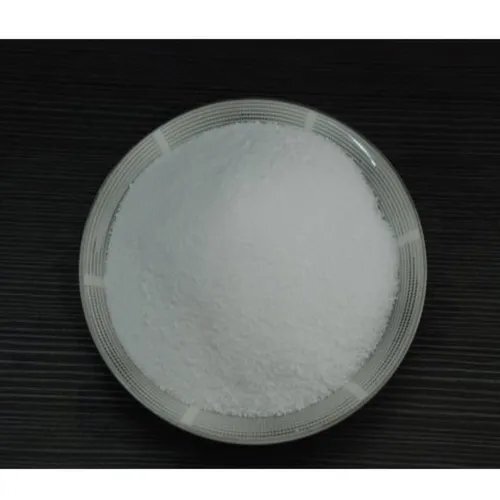
Bis 2 Chloroethyl Amine Hydrochloride
Product Details:
- Molecular Formula C4H10Cl3N
- Structural Formula ClCH2CH2NHCH2CH2ClHCl
- Molecular Weight 192.49 g/mol
- Solubility Soluble in water
- Ph Level 3.5 5.5 (5% aqueous solution)
- Color White to off-white
- Particle Size Micronized
- Click to View more
Bis 2 Chloroethyl Amine Hydrochloride Price And Quantity
- 190 INR/Ton
- 1 Kilograms
Bis 2 Chloroethyl Amine Hydrochloride Product Specifications
- 212-474-9
- 205-210C
- Amine-like odor
- <0.001%
- 2-Chloroethylamine Hydrochloride
- Micronized
- >98%
- Decomposes before boiling
- 36 months
- Pharmaceutical intermediate, organic synthesis
- YES
- Store in a cool, dry, well-ventilated place, away from incompatible substances
- Bis 2 Chloroethyl Amine Hydrochloride
- White to off-white crystalline powder
- 821-48-7
- Pharma Grade
- White to off-white
- Soluble in water
- 3.5 5.5 (5% aqueous solution)
- ClCH2CH2NHCH2CH2ClHCl
- 0.5%
- C4H10Cl3N
- 192.49 g/mol
- 29213090
- Active Pharmaceutical Ingredient (API)
- Solid
Bis 2 Chloroethyl Amine Hydrochloride Trade Information
- 10000 Kilograms Per Week
- 1 Week
- Yes
- Contact us for information regarding our sample policy
Product Description
Bis2chloroethylamine hydrochloride
Chemical Formula CHClN
Molecular Weight 19449 gmol
Overview
Bis2chloroethylamine hydrochloride is a chemical compound containing two chloroethyl functional groups attached to an amine It is a derivative of ethyleneimine and is structurally related to nitrogen mustards a class of alkylating agents
Structure
Contains a secondary amine NH bonded to two chloroethyl CHCHCl groups
The hydrochloride form makes it more stable and watersoluble
Reactivity
The chlorine atoms in the chloroethyl groups make it highly reactive
It can undergo alkylation reactions where it forms aziridinium ions which can react with nucleophilic sites in DNA or proteins
Applications
1 Precursor to Nitrogen Mustard Compounds
Used in the synthesis of mechlorethamine an early chemotherapy drug
Basis for other alkylating agents used in cancer treatment
2 Chemical Warfare Agents
Structurally related to mustard gas a vesicant blistering agent
3 Research Laboratory Use
Used in studies on DNA alkylation and cytotoxicity mechanisms
Toxicity Hazards
Highly toxic and mutagenic due to its ability to alkylate DNA
Can cause severe blistering and cellular damage
Carcinogenic and should be handled with extreme caution in a controlled lab setting
High Purity and Formulation
Manufactured to pharma-grade standards, Bis 2 Chloroethyl Amine Hydrochloride offers over 98% purity, ensuring optimal performance in synthesis and research. Its solid, micronized form allows easy handling and precise measurement for various laboratory protocols.
Safe Handling and Storage
This compound should be stored in a cool, dry, and well-ventilated area, distant from strong oxidizers and reducing agents. Proper packaging in HDPE or glass bottles ensures product integrity while minimizing exposure to hazardous elements and maintaining a stable shelf life.
Applications in Research and Industry
Bis 2 Chloroethyl Amine Hydrochloride is primarily used as a pharmaceutical intermediate and in organic synthesis projects. It is intended strictly for industrial and laboratory purposes, and its release is governed by strict regulatory compliance, prohibiting household or food-related uses.
FAQs of Bis 2 Chloroethyl Amine Hydrochloride:
Q: How should Bis 2 Chloroethyl Amine Hydrochloride be safely stored and handled?
A: Store Bis 2 Chloroethyl Amine Hydrochloride in a cool, dry, and well-ventilated place, away from strong oxidizing and reducing agents. Handle it with appropriate protective equipment, as it is toxic and may cause irritation if it comes into contact with skin, eyes, or is inhaled.Q: What is the primary usage of Bis 2 Chloroethyl Amine Hydrochloride?
A: This compound is utilized mainly as a pharmaceutical intermediate and in organic synthesis. Its high purity and stability make it suitable for controlled laboratory and industrial processes, but it is not intended for food, household, or medicinal end use.Q: When is this product beneficial for laboratory applications?
A: Bis 2 Chloroethyl Amine Hydrochloride is beneficial when purity, stability, and reliable performance are crucial in research, particularly in synthetic organic chemistry or pharmaceutical development requiring stringent quality standards.Q: Where is Bis 2 Chloroethyl Amine Hydrochloride manufactured and distributed?
A: This product is manufactured and supplied in India and is available through verified distributors, manufacturers, and traders who cater to laboratory, industrial, and R&D requirements worldwide.Q: What precautions must be taken while using this compound in the laboratory?
A: Adequate ventilation, personal protective equipment such as gloves, safety eyewear, and lab coats are essential as the compound is toxic and can cause irritation. Avoid ingestion, inhalation, and direct skin or eye contact at all times.Q: How does Bis 2 Chloroethyl Amine Hydrochloride contribute to pharmaceutical research?
A: Its high pharmaceutical grade and reliable physicochemical properties make it instrumental as an intermediate, enabling the synthesis of various active pharmaceutical ingredients in controlled environments.
Price:
- 50
- 100
- 200
- 250
- 500
- 1000+








